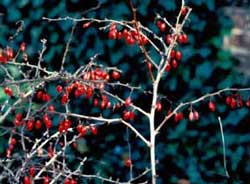Landscape Shrubs
Redleaf Japanese Barberry
(Berberis thunbergii var. atropurpurea)
There are not many plants that can be found growing from Wisconsin down to Florida, but Japanese barberry (Berberis thunbergii) is one of them. Based on the number of new varieties still being introduced to the market, it appears that this plant is still extremely popular.
One reason Japanese barberry is still so popular is that it is one tough plant. It thrives in tough sites that have a full sun exposure. The red/purple-leaf cultivars are admittedly the most popular, as homeowners get tired of green and love other foliage colors in their landscapes.
You have many (maybe too many) choices when it comes to selections of this plant. In a major plant reference I counted 25 cultivars with red/purple foliage and another 22 cultivars with other variations in leaf color or plant habit. Foliage color on the species (B. thunbergii) is a flat green. For a green-leaved form that is a very tight globe, ‘Kobold’ fits the bill. ‘Kobold’ is a great full sun substitute for Japanese boxwood (Buxus microphyllus) if you are trying to make a formal English garden in the South. A former student sent me a photograph of the brilliant red fall color on Emerald CarouselTM . This cultivar has deep green leaves during the growing season. If you must have a yellow-foliaged plant you need to look for ‘Aurea,’ Golden NuggetTM, or SunsationTM
All of the varieties/cultivars that have red/purple foliage are lumped under a botanical variety name, atropurpurea. While everyone is familiar with ‘Crimson Pygmy,’ there are certainly other fine rich purple-leaf forms such as ‘Bagatelle,’ ‘Concorde,’ and Royal BurgundyTM. Cultivars such as ‘Rose Glow’ have mottled foliage with flecks of white/pink in the red/purple leaves. If you need a red/purple foliage shrub that is very upright (5’ tall by 1’) you should get ‘Helmond Pillar.’
The small (1/4”), sulfur yellow flowers that appear in April are not considered showy. In the fall you may find a very heavy crop of lipstick red berries on the stems. Fruits, which are 1/3” long and elliptical in shape, are very noticeable once the leaves drop in the fall. In northern climates they contrast very well with winter snow. There are prominent thorns/spines on stems.
Japanese barberry is typically classified as a small or medium sized shrub (5’ tall x 6’ wide), but as you can now appreciate, there are many selections that are smaller than that. In northern climates it is likely you will see nice red/orange fall color.
Barberries are like junipers (Juniperus); they grow best in full sun. Plants will get very thin in shade, and the red/purple foliaged cultivars will not have rich color in the shade. Once established, barberries are like junipers in that they require less water relative to some other garden plants.
In general we rarely see any insect or disease on barberry. Some might be concerned about whether this plant is the alternative host for cereal leaf rust (Puccinia sp.), but in fact it is not. Some parts of the world may still restrict planting of this species just to make regulatory life simple. Japanese barberry is now being regulated for sale in some eastern states due to the invasiveness in those states. So far this does not appear to be an issue in Arkansas.
Barberry makes a great plant for a foundation bed, massed as a low groundcover, or low barrier/hedge.
- Common Name: Japanese barberry
- Varieties to look for: ‘Crimson Pygmy,’ ‘Concorde,’ ‘Aurea,’ ‘Helmond Pillar’
- Flower Color: yellow, but not showy
- Blooming period: April
- Perennial or annual: deciduous shrub
- Size: 5’ tall by 6’ wide
- Exposure: full sun
- Soil: tolerant
- Watering: moist best
- When to prune: anytime
- Suggested use: massed, foundation, low hedge
Leaves and flowers
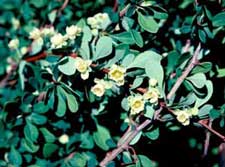
Landscaped form example
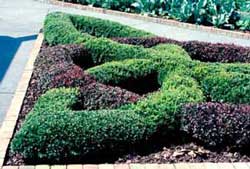
Form in fall color
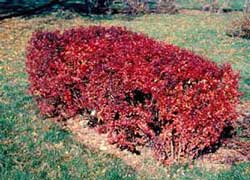
Crimson Form
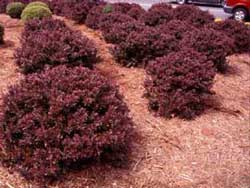
Fruit
